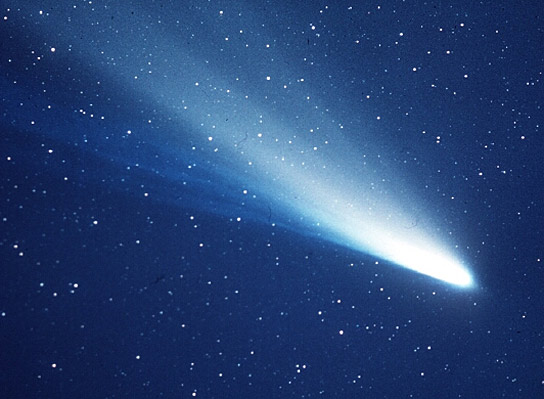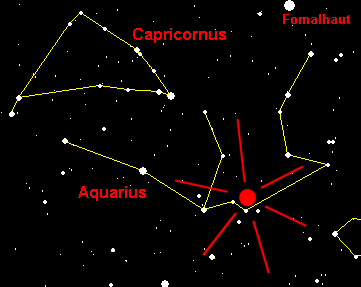
It has been 25 years since Halley's Comet last passed through the inner solar system, but an annual meteor shower keeps the icy wanderer's legacy on Earth alive this week.
Halley's Comet takes roughly 75 years to circle the sun, but if you're 30 years old or younger, you either have little or no memory of this famous cosmic vagabond's 1986 trip by Earth. And your next chance will come in the summer of 2061.
But if you don’t want to wait until 2061, you might want to step outside before sunrise during these next few mornings and try to catch a view of some "cosmic litter" that has been left behind in space by Halley's comet — a summer display of "shooting stars." [Video: Meteors from Halley's Comet]
The orbit of Halley's Comet closely approaches the Earth's orbit at two places, creating a rain of striking meteors for skywatchers during both instances. One point is in the middle to latter part of October, producing a meteor display known as the Orionids. The other point comes now, in early May, producing the annual Eta Aquarids meteor shower.
When and where to watch
The Eta Aquarid meteor shower is predicted to peak early Friday morning (May 6).
Under ideal conditions (a dark, moonless sky) about 30 to 60 of these very swift meteors can be seen per hour. And with a new moon on May 3 this is one of those years when observing conditions will be perfect. The shower appears at about one-quarter peak strength for about three or four days before and after May 6. [Spectacular Leonid meteor shower photos]
Get the Space.com Newsletter
Breaking space news, the latest updates on rocket launches, skywatching events and more!
There is, however, a drawback if you plan to watch for these meteors this year — at least for those watching from north of the equator.
The radiant (the emanation point of these meteors) is at the "water jar" of the constellation Aquarius, which comes above the southeast horizon around 3 a.m. local daylight time, never gets very high as seen from north temperate latitudes, so the actual observed rates are usually much lower than the oft-quoted 30 to 60 meteors per hour.
From North America, typical rates are 10 meteors per hour at 26-degrees north latitude (Brownsville, Texas; Naples, Fla.), half of this at 35-degrees latitude (Albuquerque, N.M.; Chattanooga, Tenn., and practically zero north of 40 degrees (Philadelphia, Penn.; Salt Lake City, Utah).
Catch an 'Earthgrazer'
For most, perhaps the best hope is perhaps catching a glimpse of a meteor emerging from the radiant that will skim the atmosphere horizontally — much like a bug skimming the side window of an automobile. Meteor watchers call such shooting stars "Earthgrazers." They leave colorful, long-lasting trails.

"These meteors are extremely long," said Robert Lunsford, of the International Meteor Organization. "They tend to hug the horizon rather than shooting overhead where most cameras are aimed."
"Earthgrazers are rarely numerous," advises Bill Cooke, a member of the Space Environments team at the Marshall Space Flight Center. "But even if you only see a few, you're likely to remember them."
Comet crumbs
If you do catch sight of one early these next few mornings, keep in mind that you'll likely be seeing the incandescent streak produced by material that originated from the nucleus of Halley's comet.
When these tiny bits of comet collide with Earth, friction with our atmosphere raises them to white heat and produces the effect popularly referred to as "shooting stars."
So it is that the shooting stars that we have come to call the Eta Aquarids are really an encounter with the traces of a famous visitor from the depths of space and from the dawn of creation.
Joe Rao serves as an instructor and guest lecturer at New York's Hayden Planetarium. He writes about astronomy for The New York Times and other publications, and he is also an on-camera meteorologist for News 12 Westchester, New York.
Join our Space Forums to keep talking space on the latest missions, night sky and more! And if you have a news tip, correction or comment, let us know at: community@space.com.

Joe Rao is Space.com's skywatching columnist, as well as a veteran meteorologist and eclipse chaser who also serves as an instructor and guest lecturer at New York's Hayden Planetarium. He writes about astronomy for Natural History magazine, Sky & Telescope and other publications. Joe is an 8-time Emmy-nominated meteorologist who served the Putnam Valley region of New York for over 21 years. You can find him on Twitter and YouTube tracking lunar and solar eclipses, meteor showers and more. To find out Joe's latest project, visit him on Twitter.









